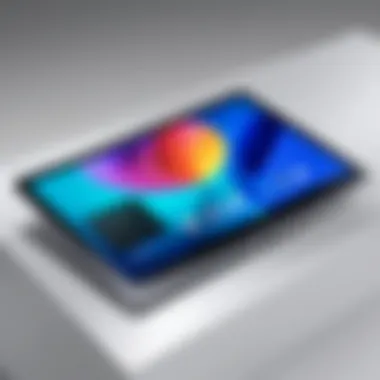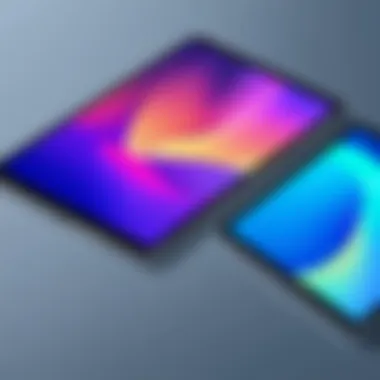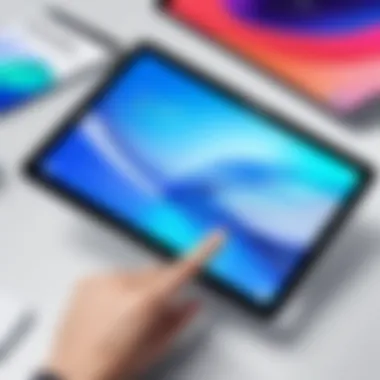Understanding Samsung Tablet Resolution: A Comprehensive Guide


Intro
In the realm of consumer electronics, display resolution plays a pivotal role in defining the overall user experience. This guide serves to dissect the intricacies of resolution in Samsung tablets, a category known for its diverse offerings. Understanding resolution encompasses both the measurement of pixel density and its practical effects, notably on tasks that users engage in daily. As technology evolves rapidly, Samsung tablets continue to adapt and redefine display capabilities. Addressing both the technical specifications and the real-world implications of resolution is essential for IT professionals and tech enthusiasts alike.
Hardware Overview
The hardware configuration of a tablet is often the backbone of its performance, especially in relation to display resolution. Different models of Samsung tablets showcase varying specifications that cater to distinct needs and use cases.
Specifications
Samsung’s tablet ranges, such as the Galaxy Tab series, display a spectrum of resolutions. These typically include:
- 1920 x 1200 pixels for mid-range models, which offers a clear image for general use.
- 2560 x 1600 pixels in premium devices, significantly improving clarity; suitable for multimedia consumption and productivity tasks.
- 2800 x 1752 pixels, found in select high-end models, delivering near pixel-perfect images, beneficial for professionals involved in graphic design or video production.
Each resolution corresponds to specific screen sizes, meaning that pixel density—measured in pixels per inch (PPI)—varies.
Performance Metrics
Resolution does not function in isolation; it interacts with several performance metrics, including processing power and battery life. For instance:
- Higher resolutions generally require more processing capabilities. Many Samsung tablets utilize powerful processors, such as the Exynos series or Qualcomm Snapdragon, capable of adequately handling high-resolution displays.
- Battery consumption is also influenced by screen resolution. A 2560 x 1600 resolution display can draw significantly more power compared to a 1920 x 1200 display, affecting overall battery life during extended use.
These performance metrics are critical in determining how effectively a tablet can utilize its resolution in real-world applications.
Software Analysis
The resolution is not merely a hardware specification. The software that runs on these devices is equally important. Samsung leverages its proprietary software to optimize the user experience across its tablet line.
Features and Functionality
Samsung’s tablets come equipped with a range of software features designed to take advantage of the hardware specifications. Notably:
- Adaptive Brightness Control: Automatically adjusts the screen brightness according to ambient light, enhancing visibility and reducing eye strain.
- Multi-Window Support: Allows users to run multiple applications simultaneously, a task made smoother with higher resolution screens that can display content clearly side by side.
These features enhance usability, making Samsung tablets suitable for varied applications, from casual browsing to intensive professional tasks.
User Interface and Experience
The One UI platform from Samsung provides a user-friendly interface that is designed with tablet resolution in mind. The clarity offered at higher resolutions contributes significantly to user satisfaction, especially during:
- Content consumption, where sharp visuals enhance movies and games.
- Document editing and multitasking, where clarity can impact productivity.
Preface to Tablet Resolution
Understanding tablet resolution is essential when choosing a device like a Samsung tablet. Resolution refers to the sharpness and clarity of an image on the screen, determined by the number of pixels horizontally and vertically displayed. High resolution means more detail and a better viewing experience. In this article, we will explore how resolution impacts the usability, performance, and overall enjoyment of Samsung tablets. With the right knowledge, consumers and professionals can make informed choices suited for their needs.
Defining Resolution


Resolution is defined as the total number of pixels displayed on a screen. It is measured as width by height, such as 1920 x 1080 for Full HD. Each pixel is a tiny dot that contributes to the overall image quality on the display.
The more pixels present in a given area, the higher the resolution. This results in more detailed and clearer images. An average user may notice that text and images appear sharper on higher resolution screens compared to lower ones. For Samsung tablets, various resolutions are offered, making it vital to understand each type to find the best match for your needs.
Importance of Resolution in Tablets
Resolution affects several aspects of a tablet's performance and usability. Here are some key features influenced by resolution:
- Image Clarity: Higher resolution offers crisper and clearer visuals, which enhance video streaming, gaming, and browsing.
- User Comfort: Users often feel less strain on their eyes when reading or viewing content on high-resolution screens.
- Multimedia Experience: For those who consume a lot of media, like Netflix or gaming, high resolution provides a more immersive experience.
- Professional Use: Artists and designers benefit from higher resolutions that allow for detailed work on graphic-heavy applications.
"Choosing the right resolution significantly impacts user experience, especially for detailed tasks like photo editing or watching high-definition content."
By understanding resolution, users can select Samsung tablets that match their lifestyle and needs, enhancing their everyday tech experience.
Common Resolutions in Samsung Tablets
Understanding common resolutions in Samsung tablets is crucial for making informed choices when selecting a device. The variations in resolution not only influence the clarity of images and videos but also impact overall user satisfaction and performance. This section will delve into the specifics of various resolutions available in Samsung tablets, offering a clear understanding of their attributes, advantages, and associated considerations. By becoming familiar with these resolutions, users can align their tablet choice with their specific needs, whether for work or entertainment.
Standard Resolutions
Many Samsung tablets feature standard resolutions that provide decent visual quality for everyday tasks. These resolutions are typically lower than Full HD but still adequate for basic activities such as browsing the web and reading. For instance, some models come with a resolution of 1280 x 800 pixels. This resolution ensures that text remains legible and images are clear, yet it lacks the sharpness necessary for high-definition content. Users who primarily use their devices for simple applications may find standard resolutions sufficient but could experience limitations when trying to view high-resolution media.
High Definition (HD) Display
High Definition displays, typically featuring a resolution of 1280 x 720 pixels, mark a notable improvement over standard displays. This advancement results in sharper images and better-defined text, which can enhance the viewing experience significantly. Samsung’s HD displays are popular among consumers who regularly watch videos or play games. The upgrade from standard resolution to HD can be compelling as it provides better color reproduction and visual fidelity. However, it’s important to note that while HD is an improvement, it may still not meet the demands of users who seek immersive experiences in high-definition media or gaming.
Full HD and Higher Resolutions
Full HD resolutions are becoming more commonplace in Samsung tablets. With a resolution of 1920 x 1080 pixels, Full HD provides a remarkable upgrade in clarity and detail. This makes it ideal for users who value a high-quality visual experience. Furthermore, some recent Samsung devices even support resolutions above Full HD, like QHD or 4K. These higher resolutions contribute significantly to visual experience, especially for applications that require high levels of detail, such as gaming or professional video editing. The pixels are packed densely enough that it becomes difficult for the human eye to discern individual pixels at a normal viewing distance, resulting in a more immersive experience.
Retina-like Displays in Recent Models
Recent Samsung tablet models have introduced what can be termed as retina-like displays. These displays often feature resolutions that exceed the basic Full HD standard, such as 2560 x 1600 pixels or higher. This enhanced pixel density provides exceptional clarity and color accuracy, making it suitable for professionals in design and media fields. Users can enjoy high-definition content in its intended quality without visible pixelation. This technology not only improves the visual experience but also enhances productivity in applications that demand precision. Such advanced displays make a noticeable difference in user experience, particularly when it comes to graphic-intensive tasks.
Comparative Analysis of Samsung Tablet Resolutions
In this section, we will delve into the comparative analysis of Samsung tablet resolutions. Understanding various resolutions helps in assessing the devices more effectively. The focus will be on several key elements:
- Visual clarity and detail: Different resolutions have a direct effect on how clearly one can see text, images, and videos.
- Color accuracy and brightness: This impacts how vibrant or true-to-life colors appear on screen.
- User experience: Variations in resolution play a significant role in how users interact with applications and content.
This analysis provides valuable insights into why resolution matters in choosing a Samsung tablet, especially for those inclined towards high-definition displays.
Visual Clarity and Detail
Samsung tablets exhibit a wide array of resolutions, which ultimately dictate the visual clarity presented to the user. The pixel density, measured in pixels per inch (PPI), is critical in this aspect. A higher pixel density results in sharper images and clearer text. For instance, a Galaxy Tab S7, featuring a resolution of 2560 x 1600 pixels, produces highly detailed images compared to a Galaxy Tab A, which has a resolution of 1920 x 1200 pixels.
Each detail counts. Fine print in documents or minute elements in images can become indistinguishable on lower-resolution devices. Therefore, graphics-heavy applications, such as photo editing or gaming, benefit immensely from a higher resolution, providing an immersive experience.


Color Accuracy and Brightness
When analyzing resolutions, one must also consider how they affect color accuracy and brightness. Samsung utilizes various display technologies, such as AMOLED and LCD. Each technology displays colors differently. AMOLED screens tend to offer deeper blacks and more dynamic colors due to their ability to turn off individual pixels. This results in a more vivid viewing experience.
Brightness is another vital factor. Higher resolutions can sometimes result in noticeable brightness discrepancies. For example, the Galaxy Tab S7 can reach a peak brightness much higher than the Galaxy Tab A. This difference affects usability in bright environments, as a higher brightness ensures that screens remain visible even under direct sunlight.
User Experience Across Different Resolutions
Evaluating user experience is essential when comparing resolutions. Higher resolutions enhance the usability of applications and content delivery. Users who often multitask may find high-resolution screens beneficial.
For instance, when watching videos or playing games, higher resolutions provide an enjoyable experience without pixelation. However, it's important to note that users with a primary focus on reading documents might find that even mid-range resolutions serve their needs adequately.
From creative professionals to casual users, preferences vary, and understanding these nuances can lead to informed purchasing decisions. Moreover, being aware of the specific content consumed helps users align their choice of tablet resolution effectively.
"Resolution is not just about the number of pixels. It's about the total experience the device offers to the user."
In summary, the comparative analysis of Samsung tablet resolutions concentrates on visual clarity, color accuracy, and user experience. Understanding these elements facilitates more informed decisions for users and professionals, ensuring that they select the right device for their needs.
Resolution and Performance
Resolution and performance significantly intertwine, especially regarding how a tablet operates under various graphical obligations. In Samsung tablets, resolution directly affects the graphical output quality and the overall speed at which tasks are executed. Higher resolution displays pack more pixels into a given screen size, leading to sharp images and details. However, this increase in pixel density necessitates stronger processing capabilities to manage the rendering of complex graphics effectively.
Impact on Processing Power
When operating at higher resolutions, the tablet’s processor must work harder. Tasks that involve detailed graphics, such as gaming or watching high-definition videos, demand substantial processing power. For instance, when comparing differentSamsung Galaxy Tab models, one can observe that those with higher resolution screens, like the Galaxy Tab S8, come equipped with more advanced processors. This advanced hardware setup enables seamless performance and enhances user experience. If the processor cannot keep up, users might encounter lag during heavy multitasking or graphical operations. Therefore, understanding the correlation between resolution and processing power helps consumers make informed decisions about the device they choose based on their specific usage requirements.
Effects on Battery Life
Battery life is another critical aspect affected by the resolution. Higher resolutions typically consume more power because the display requires more energy to illuminate the additional pixels. While recent technologies have improved energy efficiency, individuals must consider how much battery life they require from their devices. For example, a Samsung Galaxy Tab with a 2K display might offer rich visuals but could drain the battery more rapidly compared to a Full HD model. It is essential to balance between the visual quality one desires and the endurance expected from the device. Users who engage heavily with media content or gaming should be especially mindful of this effect, as it determines how long they can use their devices without recharging.
Resolution in Gaming and Multimedia Consumption
Gaming and multimedia consumption are areas where the resolution impacts user experience significantly. Gaming at higher resolutions enhances visual fidelity, making environments and character models more lifelike. However, achieving such graphical richness can also demand high performance from the hardware. Gaming tablets like the Samsung Galaxy Tab S series optimize this trade-off by combining well-engineered displays with capable processors, resulting in not only sharper images but also smoother gameplay.
In multimedia contexts, consumers prefer clearer and more vibrant displays for streaming videos or viewing photographs. Higher resolution tablets tend to reproduce colors more accurately and with better contrast, thus enriching the overall experience. Users watching films in 4K benefit from both enhanced detail and immersive visuals that standard definitions cannot provide. Thus, choosing a tablet's resolution affects not just the technical specifications but also directly correlates to the enjoyment one derives from various activities.
Usability Considerations in Professional Settings
When selecting a tablet for professional use, resolution plays a crucial role in user experience and productivity. The right resolution can facilitate clear visuals and detailed displays, which are paramount for tasks such as document editing, presentation creation, and graphic design. Professionals often rely on their devices for various forms of media consumption, and a higher resolution can significantly enhance their interaction with content.
Optimal Resolution for Productivity Applications
In professional environments, the needs for display clarity vary across applications. For most productivity tasks, a resolution of 1920 x 1200 pixels or higher is generally recommended. This resolution allows clear visibility of text and detailed graphics. Applications like Microsoft Office or Google Workspace benefit greatly from such clarity, enabling users to read fine print without straining their eyes.
Higher resolutions, such as 2560 x 1600 pixels or even 2800 x 1752 pixels found in some Samsung tablets, can improve document editing experiences and multitasking capabilities. Users can comfortably view multiple windows side by side, which enhances workflow efficiency.
Using Tablets for Design and Media Editing


For professionals engaged in design or media editing, resolution becomes even more critical. These tasks require precise color reproduction and fine detail to ensure high-quality outputs. Samsung tablets equipped with AMOLED displays exhibit rich colors and deep contrasts, making them suitable for designers and editors. A higher resolution not only allows for detailed editing but also presents meticulous color control, which is important for graphic artists.
When utilizing software like Adobe Photoshop or Premiere Pro on these tablets, a resolution of 2560 x 1600 pixels or higher is beneficial. It enables designers to work on intricate details without losing clarity. This is particularly valuable for retouching photos or editing videos where precision is essential.
Accessibility and Readability Aspects
Accessibility should not be overlooked when considering tablet resolutions. Higher resolutions can facilitate better readability for users with visual impairments. Pixels per inch (PPI) is an important factor here; devices with higher PPI values enable sharper text and images, reducing strain when reading or working for extended periods.
Moreover, adjustable display settings can enhance accessibility. Samsung tablets often come with features that allow users to modify text size and screen contrast. These features, coupled with a good resolution, can greatly benefit users who find standard settings inadequate.
In summary, understanding usability considerations in professional settings highlights the importance of selecting the appropriate resolution for various tasks. Whether for productivity applications, design work, or ensuring accessibility, careful attention to resolution can lead to improved outcomes and enhanced user satisfaction.
Future Trends in Tablet Resolution Technology
The evolution of tablet resolution technology is a critical aspect of modern computing, particularly in an environment where multimedia consumption, gaming, and professional applications are intertwined. As user demands increase, understanding these trends allows consumers and professionals alike to make informed decisions about devices. Not only do future trends affect the performance of tablets, but they also dictate the quality of experience for users.
New display technologies promise enhancements in clarity, vibrancy, and energy efficiency. Manufacturers strive for a detailed visual representation while managing processing power and battery life. As advancements emerge, they will impact productivity applications, media creation, and casual browsing, making it crucial to understand where tablet resolution technology is headed.
Emerging Display Technologies
Emerging display technologies are revolutionizing the way users interact with digital content. The introduction of OLED and microLED displays offers significant improvements over traditional LCDs. These technologies allow for deeper blacks and brighter colors, enhancing the visual experience.
- OLED Displays: Offers true black levels by turning off individual pixels, thereby increasing contrast ratios. This feature is especially beneficial for watching films or playing games in low-light conditions.
- MicroLED Displays: Delivers a high level of brightness and color accuracy without the burn-in risk associated with OLED. It also supports higher resolutions and improves energy efficiency.
- 8K Resolution: While still rare in most tablets, the move towards 8K resolution is on the horizon. This resolution presents four times the detail of 4K, allowing for exceptionally crisp visuals, particularly important for professionals in graphic design or video production.
"The future of tablet displays is not just about higher resolutions, but about more intelligent use of technology to benefit user experience."
These innovations are designed not only for entertainment but also for professional use. Designers and editors can greatly benefit from enhanced color accuracy and detail, making tasks more efficient.
Predictions for Upcoming Samsung Models
Samsung has consistently pushed the boundaries of what tablets can achieve. Their upcoming models are expected to incorporate the latest display technologies and trends. Predictions suggest several exciting possibilities:
- Integration of 120Hz Refresh Rates: Higher refresh rates improve fluidity in scrolling and gaming, providing a superior user experience, especially important for gaming and video playback.
- Improved Color Accuracy: As tablets move towards professional-grade devices, better color accuracy is vital for creative work. Upcoming models might adopt advanced algorithms to enhance this aspect.
- Flexible Displays: With the increasing interest in foldable technology, future models may feature flexible displays, allowing for innovative designs that enhance portability without sacrificing screen size or resolution.
- Energy Efficiency Innovations: Improved battery life is necessary for professionals on the go. Future models may adopt power-saving technologies that allow for high-resolution displays while extending battery longevity.
As these predictions materialize, it's apparent that Samsung will remain at the forefront, shaping tablet resolution trends for years to come. The strategic emphasis on resolution, display technology, and user experience ensures that consumers not only have access to high-quality devices but also benefit from a sustainable future in tablet technology.
Epilogue
The conclusion of this article serves as a pivotal point in synthesizing the various aspects of resolution in Samsung tablets. This section is critical as it reiterates the main insights and takeaways from the previous discussions. By consolidating the key points, it helps to frame the reader’s understanding of how resolution impacts different aspects of tablet use, from casual browsing to professional tasks.
Summary of Key Insights
In reviewing Samsung tablet resolution, several main insights emerge:
- Importance of Resolution: Resolution directly affects visual clarity and detail, influencing both leisure activities and professional tasks. Higher resolutions provide a clearer image, which is essential for photo editing or intricate design work.
- Performance Link: There is a notable connection between resolution and a tablet's performance. Higher resolutions can demand more from the processing power, which may impact the battery life and overall efficiency of the device.
- User Experience: Different resolutions cater to diverse user preferences. For example, a full HD display enhances video streaming experiences, while lower resolutions may suffice for basic tasks like reading.
- Future Trends: Emerging technologies suggest that Samsung's future tablets will continue to evolve in terms of display resolution, potentially offering more immersive experiences, especially with OLED and 8K capabilities on the horizon.
These insights underline the essence of making informed choices when selecting a Samsung tablet tailored to user needs and expectations.
Final Thoughts on Samsung Tablet Resolutions
As technology progresses, Samsung is likely to enhance its display offerings. Newer models may include even more advanced resolutions and panel technologies that cater to a growing demand for higher fidelity visuals. Focusing on resolution, as examined in this article, provides valuable perspectives on making informed purchasing decisions. It helps anticipate how the advances in display technology can change the way we interact with digital content.
Ultimately, understanding Samsung tablet resolutions empowers users to select devices that best suit their needs. The relationship between resolution, performance, and usability is significant in navigating the complexities of modern tablets.



